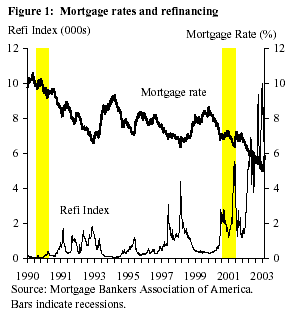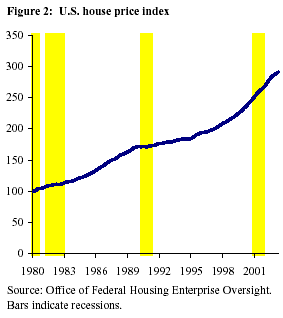One of the defining characteristics of the 2001 recession was the resilience of consumer expenditures. Many commentators have pointed to the housing market as one source of strength in consumption.
One of the defining characteristics of the 2001 recession was the resilience of consumer expenditures. Many commentators have pointed to the housing market as one source of strength in consumption. This claim is usually based on two observations. First, the combination of high homeownership rates and low interest rates has allowed many households to refinance to get more favorable rates and terms on their mortgages, adding a potentially large amount to monthly disposable income. A homeowner who took out a $150,000 mortgage at the height of the stock market boom in 2000 and refinanced in July of 2003 saved $304 per month due to the declining cost of credit. A second, and potentially more powerful, source of strength comes directly from the increase in house prices. Mortgage lenders report that large numbers of consumers not only refinanced to lower mortgage rates, but also extracted equity from their houses by refinancing for larger amounts.
These developments in mortgage markets and mortgage refinancing are giving researchers a renewed interest in homeownership and housing wealth and their links to consumption over the business cycle. In this Economic Letter, we review some of the research literature on the factors affecting refinancing decisions, as well as some of the trends that have affected mortgage markets and lowered the transaction costs associated with refinancing.
As with all economic decisions, the decision to refinance will depend on the costs of refinancing and the expected proceeds from doing so. On the cost side, it is important to note that the refinancing option is valuable to a borrower and, thus, must be paid for. This cost can take two forms. First, any refinancing results in the origination of a new loan, which generates a set of fees. Second, borrowers may have to pay a prepayment penalty. This cost can arise because, whenever it is advantageous for borrowers to refinance at lower interest rates, it is also disadvantageous for lenders to get their money back. Borrowers with no prepayment penalty mortgages are presumably paying for this option in the form of a higher interest rate.
The majority of the academic research by economists on mortgage refinancing has focused on understanding why and when homeowners choose to refinance. At heart, this should be a simple problem for households to solve: households should compare the present value of the reduced mortgage payments over the life of the loan to the cost of refinancing. Since the refinancing cost is fixed in the short run, households should simply wait until interest rates fall enough relative to their current rate, and then refinance. Indeed, commonly cited rules of thumb, such as “refinance every time the mortgage rate drops by 50 basis points,” reflect this kind of decisionmaking. But research has shown that households often delay refinancing, even when it appears optimal to do so according to standard models (Stanton 1995). Evidently, a combination of future interest rate uncertainty (interest rates could continue to fall), uncertainty about the duration of stay in a house, and other borrower demographics are important determinants of the refinancing propensity as well.
Bennett, Peach, and Peristiani (1998) study refinancing in the 1990s and document some of the empirical facts of mortgage refinancing behavior. All other things held equal, they show that households are more likely to refinance when interest rate volatility is low, home equity values are high, and creditworthiness is good. As early as the mid-1990s, they note the structural changes in refinancing behavior over time—a point which has become increasingly apparent in the present day.
Another strand of the literature has examined the role of house value in a household’s wealth portfolio and how savings and consumption are affected by this wealth. This is a relatively new area of research in finance and macroeconomics that is receiving increasingly more attention given the sheer size of housing in the portfolio. A house typically accounts for one-third of total household wealth and nearly 70% of U.S. households own their homes. When the head of the household is over 50 years old (i.e., households with the largest wealth), the homeownership rate is over 80%. Krainer and Marquis (2003) model the mortgage contract in a dynamic setting and trace out the implications of house price increases and interest rate cuts on consumption through this channel. They show that the amount of mortgage refinancing will depend not just on recent interest rate changes or levels, but also on the whole history of interest rate changes and levels. Refinancing activity also will depend on the history of house prices. Refinancing will be tempered when housing demand is weak (defined as a low rent, or low housing service flow value), even if interest rates are falling.
Hurst and Stafford (2002) use data from the Panel Study of Income Dynamics to investigate how households use their housing wealth to smooth their consumption. In particular, they show that housing wealth can act as a hedge against adverse economic shocks. In the early 1990s, financially constrained households suffering unemployment spells were 25% more likely to refinance than less constrained households. The authors estimate that refinancing households spent two-thirds of every dollar extracted from refinancing.
Recent trends in mortgage refinancing
The evidence on mortgage refinancing activity shows that the incentive to refinance varies over time and has been especially strong in recent years.  Figure 1 plots the Mortgage Bankers Association Refinance Index against the 30-year fixed rate mortgage from Freddie Mac’s weekly survey. Changes in the refinance index represent percentage changes in mortgage refinancing applications from the previous month. A number of features quickly emerge from the data. First, increases in the index are sharply concentrated around local low points in the interest rate series. For example, at the end of 1991, a brief downward spike was accompanied by a similar increase in the Refi Index. Also apparent in the data is the short-lived nature of changes in the refinancing index. Once interest rates dip to a point where refinancing is profitable, households appear to refinance quite quickly. When rates rise after hitting a low point, as they did in late 1998, refinancing completely dries up.
Figure 1 plots the Mortgage Bankers Association Refinance Index against the 30-year fixed rate mortgage from Freddie Mac’s weekly survey. Changes in the refinance index represent percentage changes in mortgage refinancing applications from the previous month. A number of features quickly emerge from the data. First, increases in the index are sharply concentrated around local low points in the interest rate series. For example, at the end of 1991, a brief downward spike was accompanied by a similar increase in the Refi Index. Also apparent in the data is the short-lived nature of changes in the refinancing index. Once interest rates dip to a point where refinancing is profitable, households appear to refinance quite quickly. When rates rise after hitting a low point, as they did in late 1998, refinancing completely dries up.
The most obvious feature of Figure 1 is the enormous volume of refinancing throughout 2000-2002—a period overlapping with the most recent recession. The differences in refinancing activity during this episode and the previous recession help to illustrate some, but not all, of the factors affecting the propensity to refinance cited earlier. It is clear that falling interest rates alone will not necessarily trigger a boom in refinancing. Indeed, in the early 1990s, interest rates fell by approximately the same amount as they did between 2000:Q2 and the present day (approximately 4 percentage points). But in the early 1990s, there was nothing like the current wave of refinancing. One clear difference between the two periods is that house prices remained flat during the 1990 recession, while they appreciated strongly in 2000-2002 even as economic activity has slowed  (see Figure 2), making it possible for households to extract built-up equity (see Mattey and Wallace 1998 for evidence on the importance of house prices in mortgage prepayment models, more generally).
(see Figure 2), making it possible for households to extract built-up equity (see Mattey and Wallace 1998 for evidence on the importance of house prices in mortgage prepayment models, more generally).
But even taking into account the traditional determinants of households’ propensity to refinance, the figure suggests that something else has happened to increase the rate of refinancing. This may be due to technological change on the cost side. Credit scoring models have reduced the time it takes to determine whether borrowers qualify for loans, enabling them to take advantage of interest rate moves more quickly. Other improvements in information processing have chipped away at the fees associated with originating the new loan. For instance, some mortgage lenders will waive the appraisal fee for existing customers on straight rate and term refinancings. Finally, the improved search capabilities brought by the Internet have increased competition. The ability of consumers to compare refinancing costs has never been better.
Quantifying the extent of mortgage refinancing and the uses of cash-outs is difficult due to the limited amount of information on what households have done with their gains from refinancing. An important glimpse at the economic impact of refinancing can be found in research by Canner, Dynan, and Passmore (2002). Using survey data, the authors estimate that U.S. homeowners saved an annual $4.7 billion in mortgage payments (net of increases in loan principal) through refinancing and $131 billion in cash-out refinancing in 2001 and early 2002. The majority of the funds raised through cash-outs was used for home improvements, consumption expenditures, and the restructuring of existing household debt. The authors estimate that cash-out refinancing could have added as much as one-half percent to aggregate personal consumption expenditures in 2001.
Of course, the wave of cash-out refinancing has resulted in many households increasing their debt levels. In the October 2002 Senior Loan Officer Survey, which covers approximately 60 domestic and foreign banks, one-half of the respondents reported that between 20% and 40% of their customers refinanced for more than the outstanding principal. The majority of banks reported that the typical increase in principal was in the 5%-15% range.
The current refinancing boom is interesting because it appears to represent a structural change in the economy. If technological change has caused refinancing to become cheaper, then two important implications follow. First, houses must have become more valuable assets, for now they are more easily pledged as collateral. Second, adverse economic shocks to household wealth now could be easier to absorb since home equity can more easily be tapped in order to smooth consumption.
John Krainer
Economist
Milton Marquis
Professor of Economics, Florida State University
References
[URLs accessed September 2003.]
Bennett, P., R. Peach, and S. Peristiani. 1998. “Structural Change in the Mortgage Market and the Propensity to Refinance.” FRBNY Staff Report 45. http://www.ny.frb.org/rmaghome/staff_rp/sr45.html
Canner, G., K. Dynan, and W. Passmore. 2002. “Mortgage Refinancing in 2001 and Early 2002.” Federal Reserve Bulletin (December), pp. 469-481. http://www.federalreserve.gov/pubs/bulletin/2002/02bulletin.htm#dec
Federal Reserve Board of Governors. 2002. Senior Loan Officer Survey on Bank Lending Practices.
http://www.federalreserve.gov/boarddocs/SnLoanSurvey/200211/default.htm
Hurst, E., and F. Stafford 2002. “Home Is Where the Equity Is: Mortgage Refinancing and Household Consumption.” Forthcoming in Journal of Money, Credit and Banking.
Krainer, J., and M. Marquis. 2003. “Mortgages as Recursive Contracts.” FRBSF Working Paper 2003-03.
http://www.sf.frb.org/economic-research/papers/2003/wp03-03bk.pdf
Mattey, J., and N. Wallace. 1998. “Housing Prices and the (In)stability of Mortgage Prepayment Models: Evidence from California.” FRBSF Working Paper 98-05. http://www.sf.frb.org/economic-research/workingp/wp98-05.pdf
Stanton, R. 1995. “Rational Prepayment and the Valuation of Mortgage-Backed Securities.” Review of Financial Studies 8(3), pp. 677-708.
Opinions expressed in FRBSF Economic Letter do not necessarily reflect the views of the management of the Federal Reserve Bank of San Francisco or of the Board of Governors of the Federal Reserve System. This publication is edited by Anita Todd and Karen Barnes. Permission to reprint portions of articles or whole articles must be obtained in writing. Please send editorial comments and requests for reprint permission to research.library@sf.frb.org